Popular beading refers to the types of creativity that allow you to create jewelry, items for interior decoration with your own hands. It is recommended to select from a variety of options for children understandable and simple patterns of bead weaving, according to which they can work independently after receiving the necessary instructions.
Types of beads
Before you begin mastering weaving skills, you need to decide what kind of beads to buy, as there are different types. This material is classified according to several indicators.
Form
It is essential to pay attention to the shape of the beads when purchasing, as the aesthetics of the future product depends on it.
The following types are distinguished:
- round;
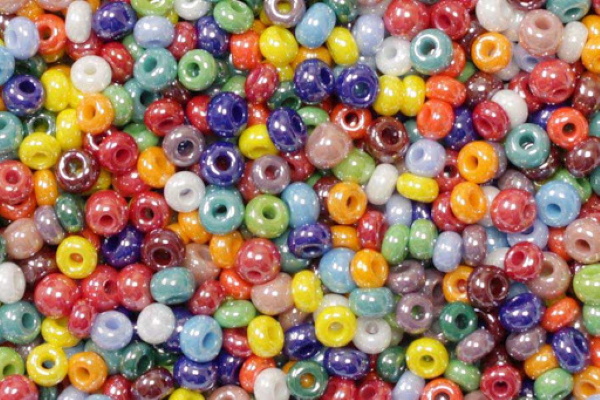
- chopped;
- cylindrical;
- resembling a donut;
- hexagonal;
- long glass bead.
Size
The size of the beads plays an important role. The configuration and decoration of the products, the speed of work depend on this indicator. Manufacturers have different standards, so pay attention to the labels. For example, Japanese beads are marked as 15/0. This means that 15 beads of a certain size fit on a piece of about 25 mm long (1 inch).
Table. Sizes of Japanese beads, mm:
| Marking | 15/0 | 11/0 | 8/0 | 6/0 |
| Size, mm | 1.5 | 2,2 | 3.0 | 4.0 |
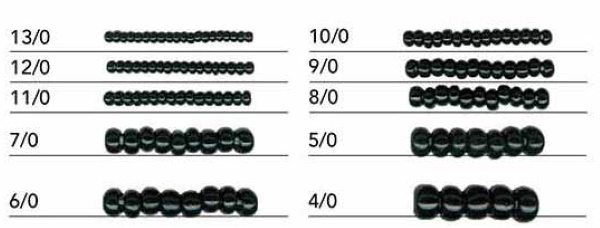
Beads can be ceramic, glass, plastic. Japanese and Czech materials are considered the most accurate in size. The most accessible and popular type remains the Chinese one, but when buying it, you need to take into account that even in one package there are beads of different sizes.
Calibration
If the product requires the use of beads of equal size, then you have to spend time to calibrate it. More often this operation is required for Chinese material.
You can string the beads you are using on a fishing line and visually estimate their size. There are recommendations for checking with a ruler. Some people use homemade sieves. They take tin cans and make holes of the required diameter in the bottom. Using such devices, you can quickly sort a large volume of material.
Beading tools
Beading for children, the patterns of which are easy to find in various publications, is based on the use of a number of tools and devices. Their selection depends on the type of the main material.
Thread
To string beads, you need a thin and strong polyester thread. In some cases, they use a fishing line, the thickness of which varies from 0.2 to 0.5 mm. It should be taken into account that these types are not suitable if the work is carried out using glass beads or chopping.
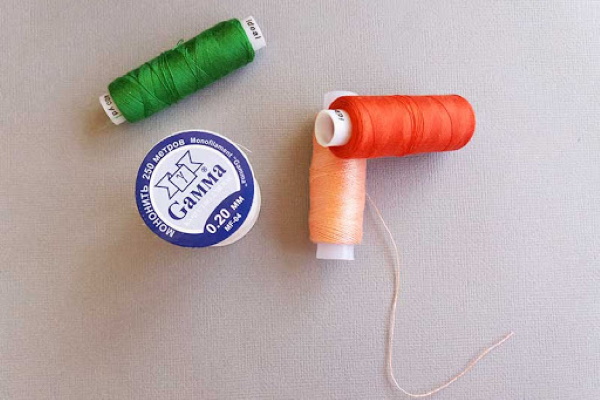
These varieties quickly damage the fragile base. In such a situation, it is recommended to use a thread made of nylon or silk. A convenient material that allows you to give the desired shape, which is often required when weaving flowers or toys, is thin (0.2-1 mm) copper or brass wire.
Needle
If working with beads involves using threads, then choosing a needle for it becomes important. It should not have a thickening in the eye area.
The needle size is selected according to the diameter of the beads.
It is convenient to buy a set of special needles for beads for handicrafts. Their thickness has a certain designation and varies from No. 10 to No. 16. The thinnest needle corresponds to the largest number.
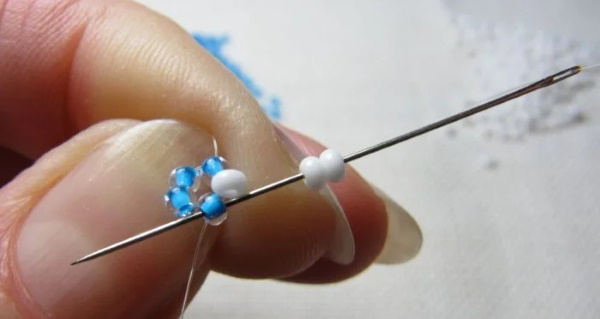
Needles also differ in length. This indicator plays a role when weaving specific items. The longest ones (5-10 cm) are required if a lot of beads are strung during the set. In terms of quality, it is advisable to give preference to Australian, English, Indian needles, which are made of durable steel. Chinese and Japanese needles are cheaper, but they break more often.
Other tools
When working with beads, you will also need other tools, which you should stock up on in advance:
- scissors;
- fittings (locks, earwires, pins for jewelry);
- pin clamp pliers;
- tweezers, which are convenient for taking small materials;
- wire cutters when working with wire.
Basic weaving techniques (diagrams)
Beading for children, the patterns for which can be selected from a wide range, is a useful activity. There are various techniques.
Mosaic technique
When mastering the skills of performing mosaic bead weaving, children should be offered the most accessible patterns for perception. A distinctive feature is the alignment of beads in a clear checkerboard pattern. It is necessary to distinguish between two types of mosaic.
Even mosaic weaving
When casting on the 1st row there should be an even number of beads.
You will need:
- round beads of the same size;
- strong thread;
- a thin needle suitable for the diameter of the bead beads.
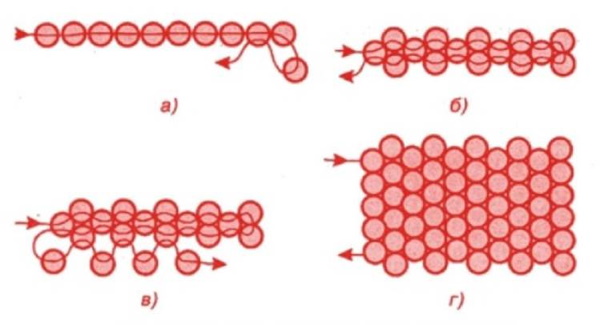
Sequence of actions:
- It is advisable to first string 1 stop bead on the thread, which is moved to a distance of about 7-8 cm from the end. Pass the needle through it 2 times. Then remove this bead.
- A precise number of beads are strung. In the example, this number is 10.
- Then, 1 bead is threaded onto the needle and passed through the hole of the second bead from the set. Repeat this, passing 1 piece at a time. After this action, 3 rows of 5 bead beads are formed in each.
- The stopper bead is removed and the ends are tied to secure it and continue to string one bead at a time, passing the needle through each protruding bead.
Odd mosaic weave
When stringing the 1st row, you will need an odd number of beads. You will also need to fix a blocking bead to make the work easier.
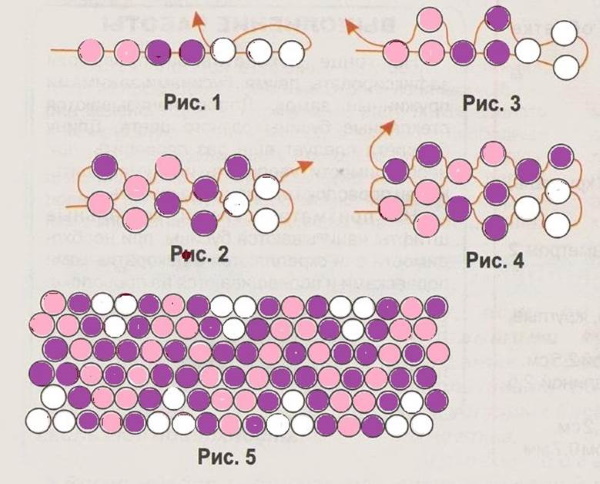
Sequence of actions:
- For example, it is recommended to string 7 beads.
- Then insert the needle into the 3rd bead from the edge, string 1 piece and continue to perform the actions in a similar manner until the end of the row.
- Here they turn around, string a bead and weave through the protruding beads of the previous row.
Repeat all actions, using the diagram as a guide.
Brick
Another type of dense mosaic fabric is obtained using the brick weaving technique.
You will need:
- beads are even and of the same size;
- nylon or silk thread;
- beading needle.

Sequence of operations:
- String 2 beads.
- Pass the needle through the holes of these beads one after another. As a result, both ends will be directed upwards.
- 1 bead is strung onto the working thread. The needle is passed from below through the 2nd (next to) bead. Then the needle is returned from top to bottom through the hole of the 3rd bead.
- Repeat until the first row reaches the desired length. For example, there are 6 pieces in the 1st row.
- For the 2nd row, put 2 beads on the needle and pass them through the thread loop between the two outer beads of the 1st row. Then string 1 bead at a time, continuing the weaving to the end.
- In subsequent rows, also at the very beginning, 2 bead beads are collected, and then 1. This will allow you to maintain the same number until the end of the weaving.
Circular
Beading using the French technique, often called circular, for children should begin with mastering simple products. The most accessible will be the patterns for making oval petals on one wire.
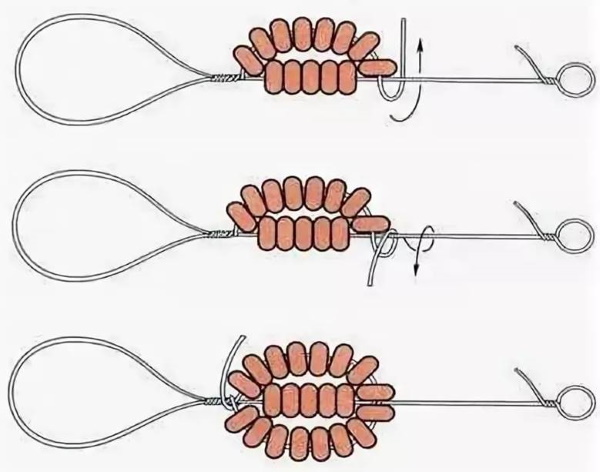
Algorithm of actions:
- Cut 70 cm of wire with a thickness of 0.3 mm.
- Make a small loop at one end.
- For example, they string 5 beads.
- Measure 15 cm from the loop and bend the wire. Step back 7 cm from the bend and twist both ends of the wire. Make the twist length approximately 2 cm.
- 8 beads are strung onto the free working end and laid along the central row. At the end, the working thread should be positioned at a right angle to the axis.
- Wrap the working end of the wire, making one turn, around the axis.
- Similar actions are performed on the other side.
The required number of rows are made, adding in each subsequent semi-oval as many beads as necessary to make the product even and neat. When the last row is completed, the upper wire is bent tightly to the back side and the excess is cut off with nippers.

The lower loop is cut. The remaining ends are twisted together with the working thread several times. They will be needed for further assembly of the flowers. If a pointed petal is required, the wire is positioned at 45° to the axis when twisting.
Parallel
The main basic movement involves passing a fishing line or wire through the entire bead row from both sides towards each other. The connection is tight with a smooth surface. The shape of the product is created by changing the number of beads collected.
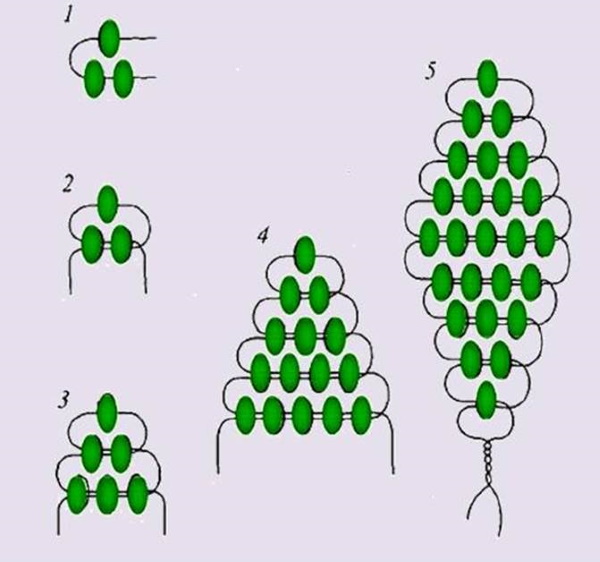
Sequence of operations:
- Cut off 25-30 cm of wire. Pick up 1 bead and move it to the middle.
- Add 2 beads on one side and pass the other end of the wire through them. Tighten to align the 2nd row.
- Then, for example, 3 beads are picked up from any side and the second end of the wire is threaded through all the holes again. Carefully tightened from both sides.
- Then, for the leaf, 4 beads are collected, and in the next row, 5 beads.
- In subsequent rows, according to the diagram, the number of beads begins to decrease. When there is 1 piece left, the ends are twisted for secure fixation.
Bracelet
Girls are happy to get involved in creative activities related to making various bracelets from beads. For beginning craftswomen, we can offer the following version of an openwork product.
Materials needed:
- fishing line 50 cm long;
- beads (you can take one or two shades);
- bracelet clasps.
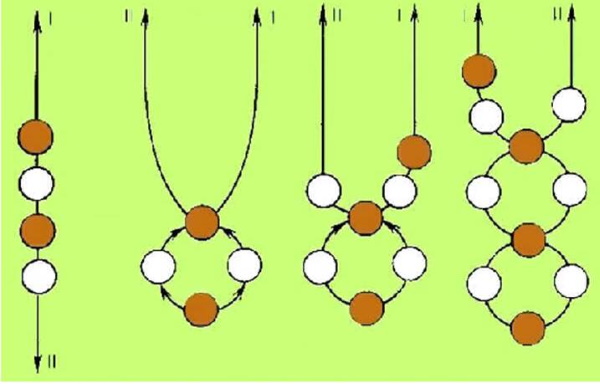
Step by step execution:
- String 4 beads onto the fishing line, moving them towards the center.
- Pass one end of the fishing line crosswise through the last bead.
- String 1 bead onto the left section of the fishing line and 2 beads onto the right section.
- The left end is passed through the top bead on the right side.
- Now string 2 beads on the left fishing line and 1 bead on the right fishing line.
- I pass the right end through the top left bead.
These actions are repeated until the bracelet reaches the required length. Its edges can be sewn or special clasps are fixed at both ends.
Earrings
Having chosen the right color scheme with the help of adult family members, children can weave exclusive earrings from beads on their own.
Materials needed:
- beads - blue, pink, red, yellow;
- silver beads;
- earwires;
- fishing line 45 cm long.

Step by step execution:
- String 5 blue beads, moving them closer to one end of the fishing line.
- Pass the second long end, which will be the working end, crosswise through the outer bead, closing the ring.
- String on a bead and a pink bead. Then, with a reverse motion, pass the line through the bead and the second bead of the ring. Again, string on the bead with the bead and repeat the motion. In total, you should get 5 such small petals.
- Bring the working end of the fishing line to the pink bead. String on a red bead, a bead, and a red bead. Pass the fishing line through the next pink bead and string again. Continue around the entire circle.
- Direct the fishing line from the red bead towards the pink one. Pick up 3 yellow beads and pass the fishing line through the next red bead, as well as the bead and another red one. Make a yellow set again. Repeat 4 times.
- In the fifth space, string 2 yellow beads, then string an earwire and 2 yellow beads again.
To give the product stability, the line is once again passed along the entire outer edge, and then the line is cut and secured.
Flowers
Beaded flowers can be made using a variety of weaving techniques. Children who have mastered parallel weaving can be offered to make a bouquet of forget-me-nots.
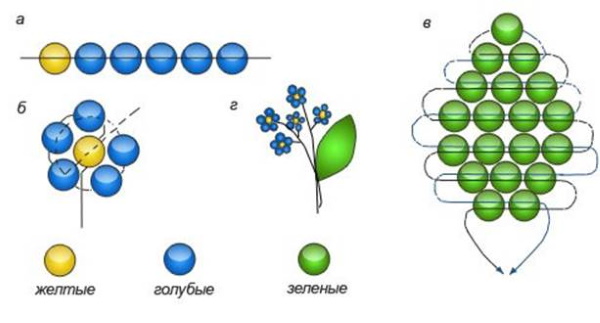
Materials needed:
- thin copper wire;
- large round beads of green, blue and yellow colors.
Step by step execution:
- Start working with weaving flowers. Cut 10 cm of wire. Put 1 yellow and 5 blue beads on it. Move them to one end, leaving about 3 cm of wire after the yellow bead.
- The working end of the wire coming out of the blue bead needs to be passed through the 2nd, 3rd, 4th and 1st (yellow) bead. Carefully place the yellow bead in the center of the flower and twist both ends of the wire under it.
- For the leaf, cut another 20 cm of wire and put on 1 green bead.
- Then 2 pieces are strung on one end, and the other is passed through both holes towards each other.
- Using the parallel weaving technique, continue to form the leaf, picking up 3 beads in the 3rd row, and 4 pieces in the 4th and 5th.
- In the 6th row, they begin to decrease the quantity by stringing 3 pieces.
- In the final 7th row there are 2 beads, and the ends of the wire are twisted.
- The leaf is fixed to the stem of a pre-made flower.
You can attach several flowers and leaves to one stem or form a bouquet of single buds. The child will be able to implement a variety of options.
Animals
Beading for children, the patterns for which surprise with their diversity, allows you to create expressive bright animal figures. The main weaving is done using a parallel method. Over time, a child who is passionate about such creative activity will be able to collect a whole collection.
Frog
Materials needed:
- green, white, black round beads;
- wire about 50 cm long.
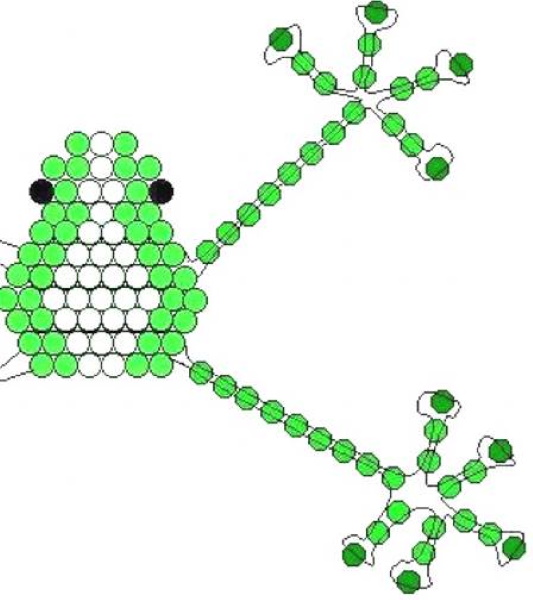
Step by step execution:
- String 3 beads (green, white, green) and place them in the middle of the wire.
- With one end, pierce all the holes from the back side, but do not tighten too much, forming an even 1st row.
- For the 2nd row, you will need to string 5 beads (2 green, white, 2 green) on one side of the wire. The other end goes through all the holes and lays the beads evenly, pressing them to the 1st row.
- In the 3rd row, the order will be: black, green, 2 white, green, black. It is important to understand that the black beads represent the frog's eyes.
- 4th row: 2 green, white, 2 green.
- 5th row: 2 green, 2 white, 2 green.
- 6th row: 2 green, 3 white, 2 green.
- Start making the upper paws. String 11 green beads onto the wire. Then pass the outer one, and pass the end of the wire in the opposite direction through the next two beads, getting the 1st "finger".
- Pick up 3 pieces and again pass the top bead, passing the wire through the 2 lower ones. Repeat this twice more to get a total of 4 "fingers".
- Then pass the wire through 8 beads, returning to the body.
- The same actions are repeated on the other side.
- 7th row: 2 green, 4 white, 2 green.
- 8th row: 2 green, 5 white, 2 green.
- 9th row: 2 green, 4 white, 2 green.
- 10th row: 2 green, 3 white, 2 green.
- The lower legs are formed in the same way as the description given for the upper limbs.
- 11th row: 2 green, 2 white, 2 green.
The ends of the wire are carefully woven into the overall design, securely fixing them. Thanks to the flexible base, the frog can be given any shape.
Keychain
A child can make a beautiful keychain resembling a watermelon slice on their own using parallel weaving technology.
Materials needed:
- flexible wire about 50 cm long;
- round beads of black, scarlet, green, white shades (if desired, use a different color);
- keychain ring.

Step by step execution:
- Apply the wire folded in half to the ring and thread both free ends through the loop, fixing them securely.
- String a scarlet bead onto one end of the wire. Pass the other end through the hole, securing the 1st row.
- Then they pick up scarlet, black, scarlet on one side, and with the other end of the wire they pass through all the beads of the 2nd row.
- For the 3rd row you will need black and 4 scarlet beads.
- The next 4th row consists of scarlet, black and 5 scarlet bead beads.
- To create the 5th row, you need to string black, 3 scarlet, black, 4 scarlet beads.
- Form the 6th row from 11 white beads.
- For the final row you will need to string 13 green seed beads.
The ends are secured by weaving them among the beads.
Chain
Children are invited to weave a beautiful chain in two rows, using a simple and accessible pattern.
Materials needed:
- silk thread;
- round beads of golden, mother-of-pearl or silver color;
- thin needle.
Step by step execution:
- Pick up 2 beads with a needle and move them closer to the end of the thread. Tie the ends with a knot so that the holes are located along the thread.
- Pass the needle from below through the hole of the left bead.
- String 2 pieces and pass the needle from the top through the right bead, then from the bottom through the left and 3rd bead. A square is formed.
- Again, pick up 2 pieces with a needle and direct them from the top through the hole of the 4th bead, and then from the bottom of the 3rd bead.
Weave in the same sequence until the chain reaches the desired length. Fix the clasps at the edges. If desired, you can simply connect the opposite ends and sew.
Interesting beadwork is one of the types of creativity accessible to children. Simple patterns are selected for them, allowing them to form motivation for interesting activities that develop perseverance, attention, and fine motor skills.
Video about beading for kids
Making ice cream from beads:
